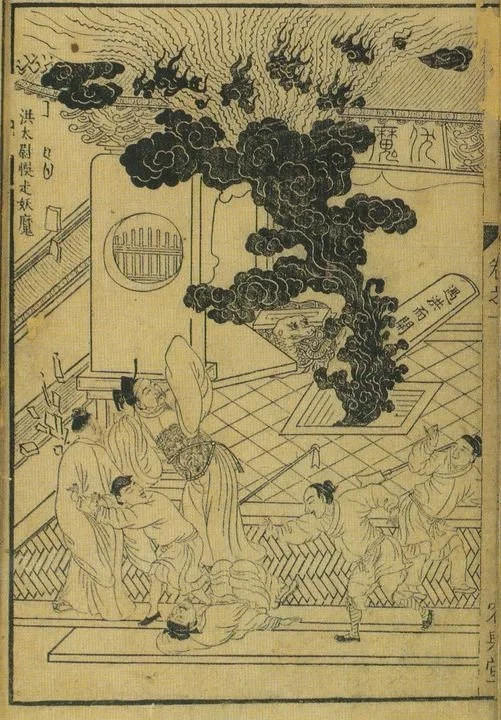A Demon-Suppressing Charm
Here’s a rubbing offering protection against demons taken from a stone tablet in the Chunyang temple at Taiyuan (太原純陽宮), the capital of Shanxi province.
Peony pattern at the top, grass pattern around the sides, talisman in centre and fine text – hard to see here – either side
Chunyang temple was possibly founded during the thirteenth century, though some sources date it to the Wanli reign (1572–1620). Laid out with nine halls and five stone-flagged courtyards, there are gnarled old trees, arched gateways built from heavy stone blocks and low-roofed buildings with blue tiles and flared eaves; the whole place radiates age and calm solidity. It’s dedicated to the semi-mythical Daoist Lü Dongbin, whose dumpy, life-sized statue, grimed from centuries of incense smoke, sits placidly inside the Lü Ancestral Hall (呂祖廟), surrounded by replica frescoes illustrating his life (the originals are in the Yongle Gong at Longquan village near Ruicheng town).
Iron lion guarding the entrance to Chunyang temple
According to legend Lü Dongbin was born in the late eighth century, and for a while served as a minor official. One day he dozed off while cooking some yellow millet and dreamed that he rose to great rank and riches, married well and had children before his jealous colleagues undermined his position and had him dismissed. Lü’s wife abandoned him, his children were killed and he died penniless in the gutter.
Waking with a start after living eighteen years in the dream, Lü found that the millet was only just cooked. Taking this as a warning about the transitory nature of life, he began studying Daoism with Zhongli Quan and along with him became one of the Eight Immortals of popular Chinese religion. Lü is usually depicted as a handsome bearded scholar – he enjoys a reputation as a ladies’ man – holding a fly-whisk or palm leaf in one hand and with a sword slung over his back.
Painting of Lü Dongbin in the Philadelphia Museum of Art
As a Daoist Immortal, Lü has immense power over demons, which brings us back to the temple’s stone tablet. Shaped like a headstone and over a metre tall, the centre of the tablet is engraved with indecipherable talismanic script, flanked by vertical columns of explanatory text in regular Chinese characters.
The text begins by explaining that “evil” and “good” are products of the human mind: people who think virtuous thoughts create a peaceful world, while those that have evil thoughts are the cause of malignant ghosts and demons. Having seen countless numbers of people harmed by evil spirits, the writer has created this talisman in the name of Lü Dongbin:
The tablet subdues what is hidden under the temple. I sincerely hope that everyone will take a rubbing and make pious offerings to it, so that it can pacify the home, drive away evil spirits, slay monsters and deflect plague demons. It will also benefit your dependents, protect your family and bring them good fortune. However, if the faithful say something even slightly blasphemous, they will suffer disaster. Tell all of my colleagues to beware of this.
The engraving is dated using the sixty-year calendar cycle to an “auspicious day of the Lotus month, Bingwu year of the Guangxu reign”, or some time during the sixth lunar month of 1886. It was written by Tang Shengwu and Fan Errong, under the direction of Tian Shoushan.
The original stone tablet. 126.5cm tall, apparently
These rubbings are made by laying damp, heavily-quilted paper on the tablet and using a wooden mallet to tamp the paper down into every carved crevice. A ball of cloth containing powdered ink is then tapped all over the paper, which darkens the surface but leaves the sunken areas uncoloured. All this tamping and tapping embosses the paper, easiest to see from the back.
Thick quilted rubbing paper embossed by the tamping/tapping process
Rubbings are usually made in black ink on white paper, but this one has used gold-coloured ink on black. Unfortunately, either the paper wasn’t tamped down into the stone thoroughly, or the ink was applied too thickly for the finest bits of engraving, but the explanatory text is hard to make out.
Thick ink making the finer-carved characters difficult to read
“The tablet subdues what is hidden under the temple” recalls the beginnings of the sixteenth-century novel The Water Margin, about a band of heroic outlaws taking on the corrupt and crumbling Song dynasty. An arrogant magistrate removes a similar tablet from inside a temple, releasing the 108 Heavenly Spirits imprisoned beneath to become reincarnated as the bandits.
I wonder what is lurking beneath the Chunyang temple…
Removing a demon-suppressing tablet and letting the spirits escape – illustration from a Ming copy of the Water Margin
Many thanks to Jarek Szymanski
The tablet’s text
书符缘启盖闻主人身者心也心所藏者神也. 心神正则正神佑之心神邪则邪神扰之. 是知神之邪正实因人心之邪正以阴为感召也. 然当此妖邪为虐厉鬼混行之际而恻隐为怀者不得不为之虑也. 余遍观斯世每见因邪魔而受其害 者枚举甚难爰奉纯阳祖师命书符.
勒石以镇之藏之宮下切愿人人锤印虔诚供养自能镇宅驱邪斩妖伏怪退厉鬼避瘟神. 益眷保家大吉大利也. 然此恃为敬信者言之稍存亵渎其必受殃. 告诸同人慎之切切.
光绪丙戌年荷月吉日,唐省吾敬笔,田守善经理,樊尔荣撰记






